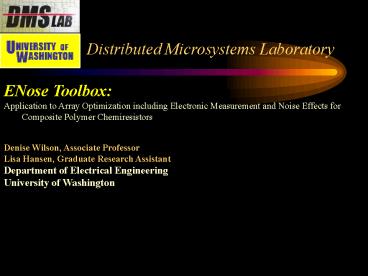Distributed Microsystems Laboratory - PowerPoint PPT Presentation
Title:
Distributed Microsystems Laboratory
Description:
Department of Electrical Engineering. University of Washington. Why a Toolbox? Introduction ... (chemistry, biology, electrical engineering, photonics, etc... – PowerPoint PPT presentation
Number of Views:77
Avg rating:3.0/5.0
Title: Distributed Microsystems Laboratory
1
Distributed Microsystems Laboratory
ENose Toolbox Application to Array
Optimization including Electronic Measurement and
Noise Effects for Composite Polymer
Chemiresistors Denise Wilson, Associate
Professor Lisa Hansen, Graduate Research
Assistant Department of Electrical
Engineering University of Washington
2
ENose Toolbox Outline
- Why a Toolbox?
- Introduction
- Motivation
- Barriers
- Approach
- Example
- Design Problem
- Design Solution
- Results
- Conclusion
- Current Status
3
ENose Toolbox Motivation
- To combine
- Background theory
- Empirical Models
- Into a general purpose simulation tool for
- Chemical
- Biological
- Mixed Mode
- Sensing Systems that can be optimized in terms of
- Number of sensors
- Redundancy of sensors
- Signal to noise behavior
- Robustness to interferents
- For optimizing and customizing designs to
appropriately targeted applications
4
ENose Toolbox Barriers
- Many chemical/biological sensor technologies do
not translate to - Through
- Across
- Variable models that can be simulated and
combined using superposition - Sensor theory is often not completely understood
- Systems cross disciplines (chemistry, biology,
electrical engineering, photonics, etc...)
causing language and research barriers that limit
simulation tools - Sensor response is often dependent on sensor
history - Interferents are numerous and problematic
- Is a hybrid (empirical/theory), evolving
simulation tool better than none at all?
5
ENose Toolbox Approach -- Based on User/Designer
Many factors (that are not often separable)
influence chemical and biological sensing systems
design. A simulation platform for these systems
must be dynamic and robust enough to incorporate
additional theory and empirical understanding as
it grows in scope and sophistication.
6
ENose Toolbox Example
- Sensor Technology composite polymer
chemiresistors - Insulating, chemically sensitive polymer
- Conductive medium
- Transduction Mechanism
- Polymer swelling is measured as an increase in
resistance - Resistance increases linearly with concentration
for small concentrations - Vulnerable to humidity, drift, other interferents
- Swelling induces a small change in resistance on
top of a large baseline - Measurement circuits must preserve resolution and
detection limit when converting small changes in
resistance to final output - Design Goal
- Optimize resolving power for discrimination of
two analytes (methanol and
benzene) - Using a heterogeneous array of composite polymer
films
7
ENose Toolbox Example
- Evaluate Design Optimization (Array Selection)
- For different measurement circuits
- In the presence of thermal noise
- Why?
- The impact of the dynamic range of the sensor
(very small changes in resistance on top of a
large baseline resistance) is often rendered
invisible by conventional means to address this
design goal. - Additional concerns (advanced stages of
simulation should address) - Effect of humidity/drift/aging/poisoning on
array behavior - Introduce compensating sensors/design measures
for these effects - Humidity sensor
- Redundant sensors to reduce variation
- Reference sensors to compensate for aging and
quantify drift
8
ENose Toolbox Example -- Results
- Two measurement circuits
- Same sensor inputs
- Wheatstone bridge (top)
- differential measurement
- eliminates baseline
- Voltage divider (bottom)
- single-ended measurement
- preserves baseline
- Separability
- Both resolving power (between analytes)
- And resolution (between concentrations) is better
for - The Wheatstone Bridge
9
ENose Toolbox Example -- Results
Array 1 Array 2 Array 3
Array 4
- Four sensor arrays
- Same stimuli
- methanol and benzene)
- Wheatstone bridge output
- Without Noise (top)
- Sensor Array 2 has the best resolving power
- With Noise (bottom)
- Sensor Array 3 has the best resolving power
- Impact of Noise
- Variations in Dynamic Range remain invisible
- Yet impact noise levels
- In real array/system design
10
ENose Toolbox Conclusions
- Because of
- Sensor response small change on top of a large
baseline (resistance) - The selection of measurement circuit
- differential vs. single-ended measurement
- Significantly impacts discrimination capability
- The presence of thermal noise
- Inherent in the chosen transduction mechanism
(resistance) - Alters the selection of optimal array for maximum
resolving power - The Enose Toolbox enables
- Access to these complicating parameters
- During the design(simulation) rather than
post-fabrication characterization of sensor array
system designs - When design changes are far less costly
11
ENose Toolbox Current Status
- Various functions, analytes, materials, and
technologies accessed in Matlab - Sensor Technologies Currently Available
- Composite polymer chemiresistors
- Tin-oxide chemiresistors
- Surface Plasmon Resonance
- Additional features
- Noise (observed in actual sensor responses)
- Coming up
- Additional sensor technologies (ChemFETs, ISFETs,
LAPS, and more) - Additional functions mixtures, equivalent
impedance - Additional features noise, drift
- Additional response characteristics transient
- Where is it?
- www.ee.washington.edu/research/enose

